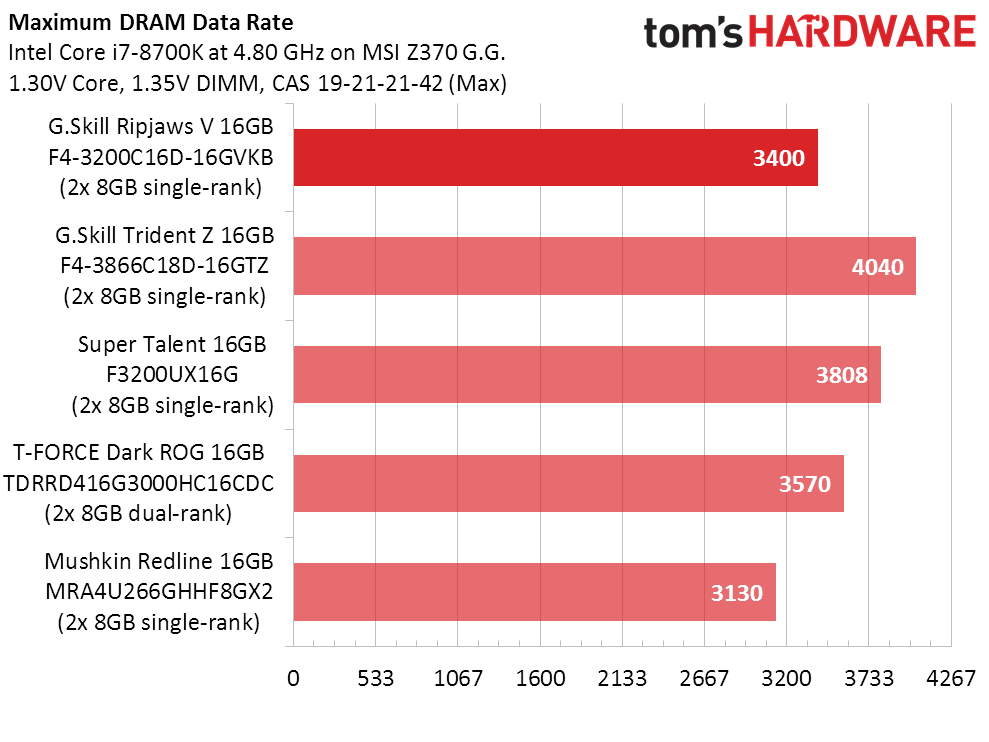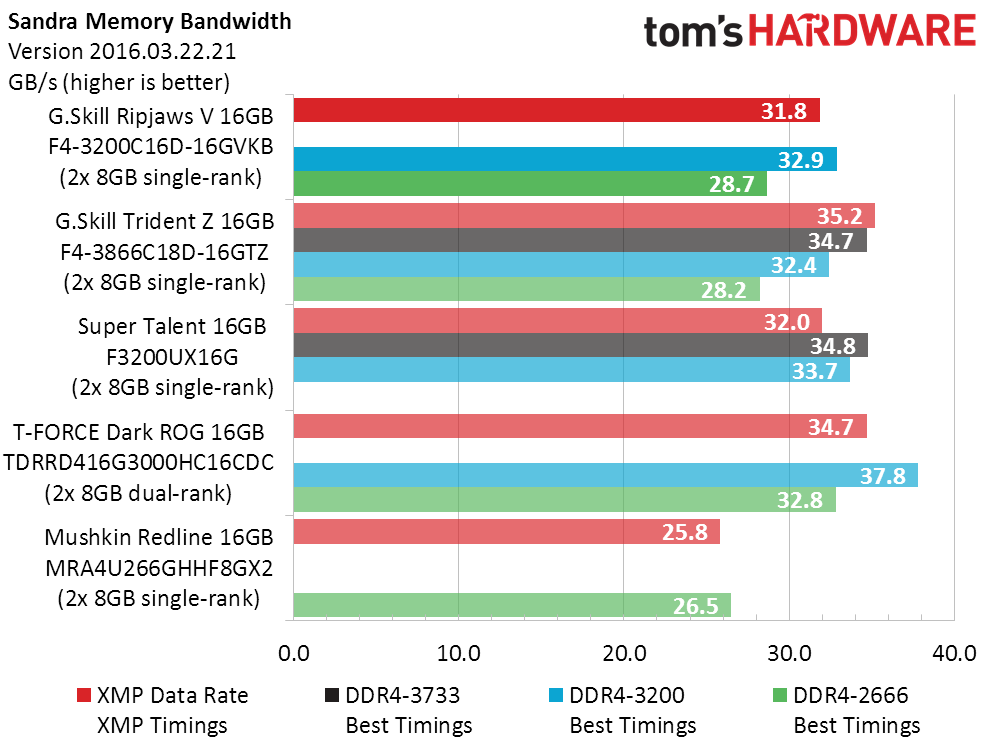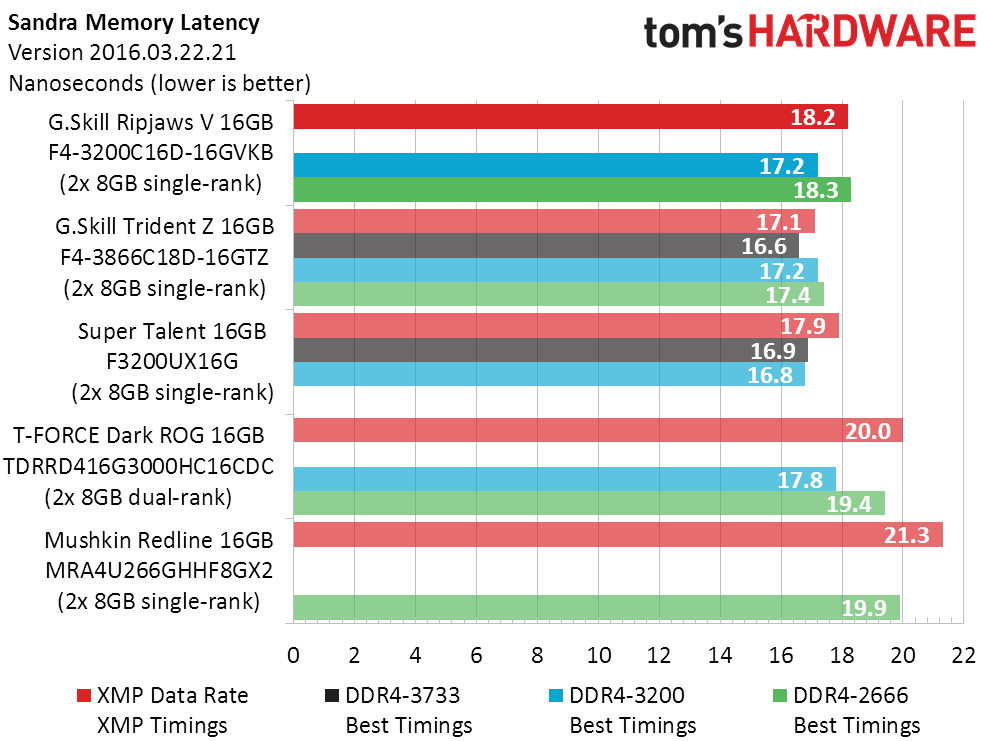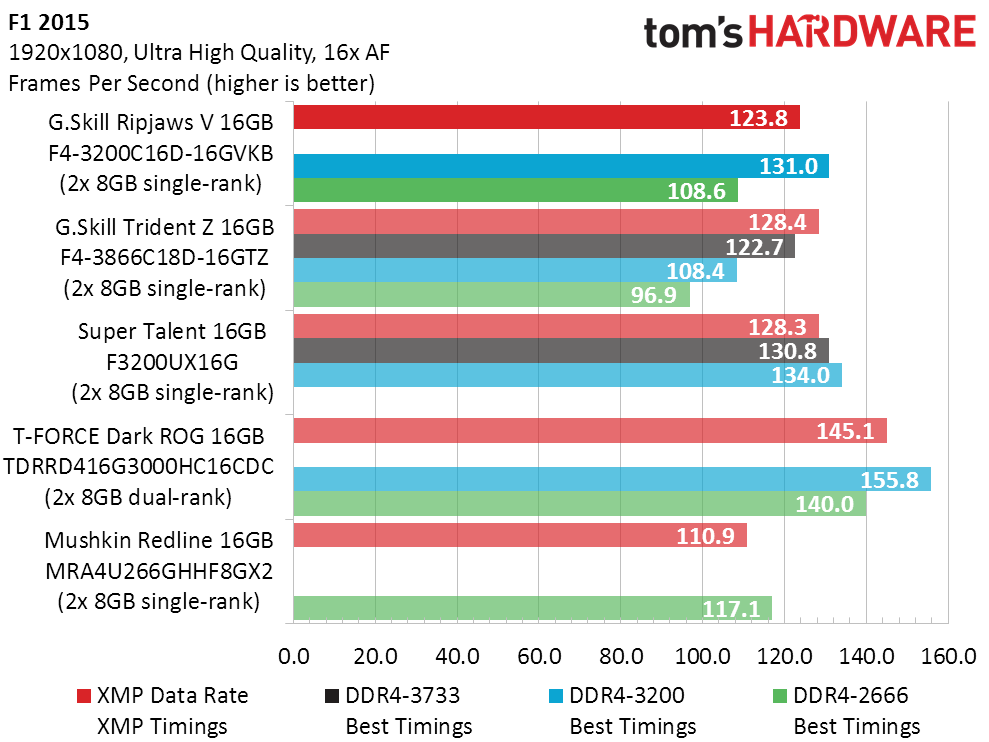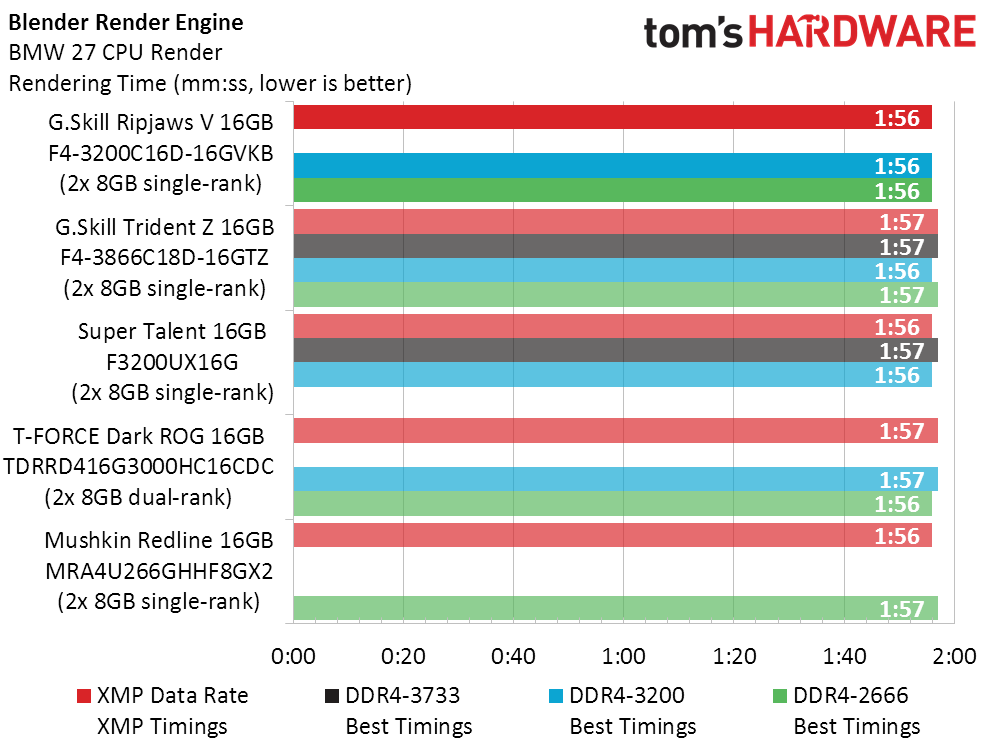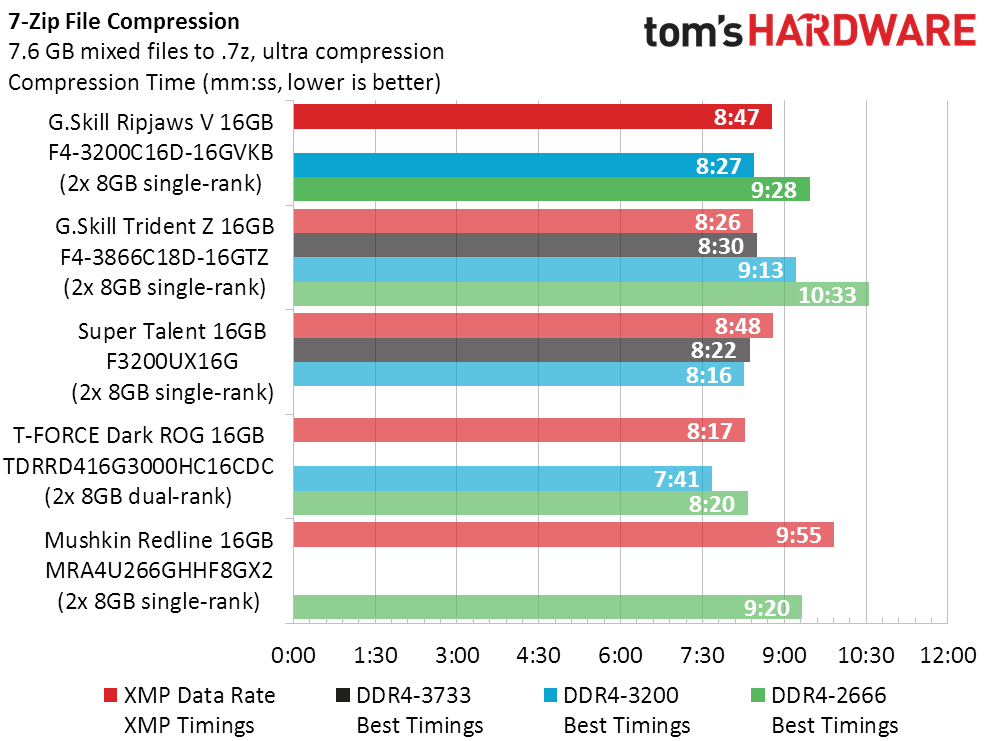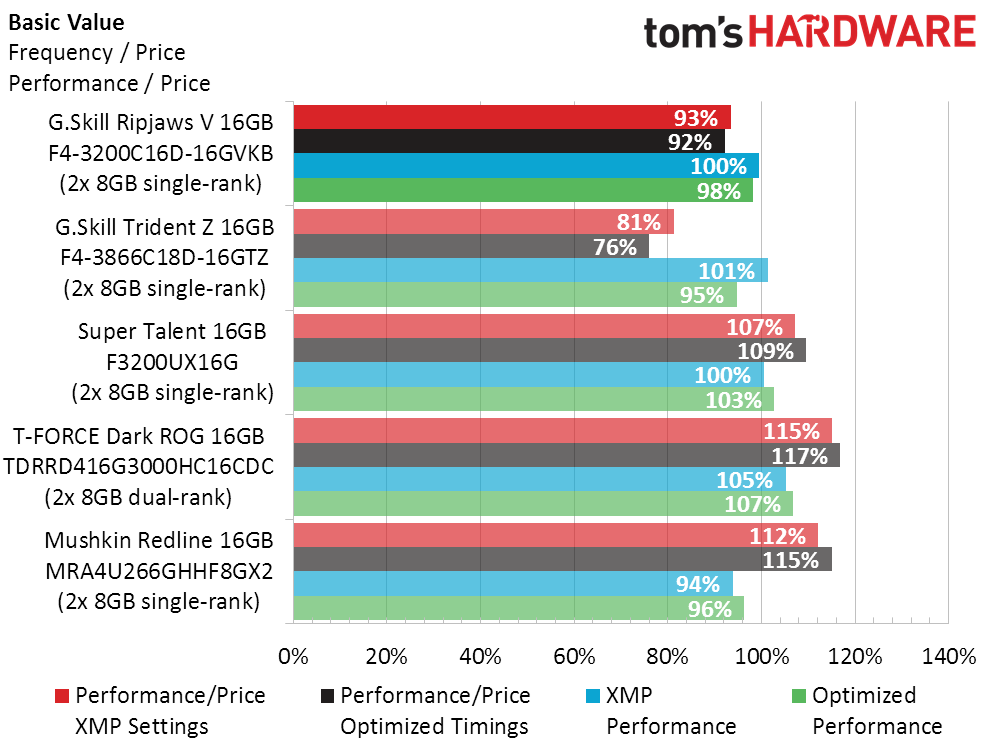G.Skill Ripjaws V DDR4-3200 C16 16GB Dual-Channel Kit Review: Gray-Area Memory
Why you can trust Tom's Hardware
Benchmark Results & Final Analysis
In addition to standard XMP testing, we’ve picked a spread of frequencies for manual timing adjustment, to see how far the performance of each kit could be pushed. The Ripjaws V DDR4-3200 didn’t reach our highest step, but we really didn’t expect it to. We were still able to push its latency down from the stock 16-18-18 timings to 15-16-16 at its rated data rate, and were even able to cut it to straight CAS 13 timings by clocking down to DDR4-2666.
| Lowest Stable Timings at 1.35V (Max) on MSI Z370 Godlike Gaming (BIOS A.30) | |||
| Row 1 - Cell 0 | DDR4-3733 | DDR4-3200 | DDR4-2666 |
| G.Skill Ripjaws V 16GB F4-3200C16D-16GVKB (2x 8GB single-rank) | X | 15-16-16-32 (1T) | 13-13-13-28 (1T) |
| G.Skill Trident Z 16GB F4-3866C18D-16GTZ (2x 8GB single-rank) | 16-17-17-34 (2T) | 14-14-14-28 (2T) | 12-12-12-28 (1T) |
| Super Talent 16GB F3200UX16G (2x 8GB single-rank) | 17-19-19-38 (2T) | 14-16-16-32 (1T) | X |
| T-FORCE Dark ROG 16GB TDRRD416G3000HC16CDC (2x 8GB dual-rank) | X | 16-17-17-34 (1T) | 13-14-14-28 (1T) |
Since the test board can’t push memory above DDR4-4200, we chose a latency limit of 19-21-21-42 cycles for our overclocking test. The extra latency didn’t help the Ripjaws V much, as it only scaled to DDR4-3400 without crashing.
The Ripjaws V DDR4-3200 nearly matches the Super Talent DDR4-3200 kit in Sandra Bandwidth, and the Ripjaws V has far better availability.
Comparing good timings to great, we can see that the Ripjaws V is slightly behind the same-speed Super Talent kit.
When equipped with a monster CPU and graphics, F1 2015 leans hard on memory. Dual-rank beats everything, though the G.Skill DDR4-3200 nearly matches its same-speed rival.
Typical of most other games, Metro noticeably penalizes abnormally slow memory configurations. The Redline DDR4-2666 isn’t abnormally slow, so it’s FPS falls only slightly behind that of the fastest modules. Being in the middle on specs, G.Skill’s Ripjaws V DDR4-3200 is also in the middle of that tight performance race.
Blender likewise punishes only the worst memory configurations, with poor encoding time. All of the modules in the chart were sufficient to make the CPU the program’s limitation.
Get Tom's Hardware's best news and in-depth reviews, straight to your inbox.
Ripjaws V is a dead match for its DDR4-3200 rival in 7-Zip, at XMP settings. For those willing and capable of playing with the timings, the competing RAM tuned up a little better.
The biggest problem in the value chart is that the black modules we tested still haven’t come down in price from their peak last year. G.Skill sells a gray set with identical specs, which has come down. And if we’d tested the gray instead of the black, it could have edged out its DDR4-3200 rival. So, as of today, our recommendation would be to go gray!
You may be wondering why we’re not shouting a recommendation for last year’s Dark ROG RAM, since its dual-rank configuration boosted it through most of our tests. The problem is that very little of the stuff is available, and if we were to push just a little, it could be gone before most of the people reading this article could get it. And there’s nothing more disappointing than recommending something that no longer exists. It’s easier to recommend 32GB kits to those who want the performance advantage of four total ranks of RAM.
The Super Talent kit is also in short supply, though the single DIMMs it’s made of (P/N F3200UA8G) are still widely available. A pair of those would only set you back just under $200, which is the same price the G.Skill modules cost in gray.
All of the midfield results mean we don’t have a good reason to recommend for or against the gray version of the tested memory kit. But we tested it in black. And even though it’s the same memory, it costs more. If you were to go for it (and it's solid enough memory) we'd recommend going with the cheaper hue.
MORE: Best Memory
MORE: DDR DRAM FAQs And Troubleshooting Guide
MORE: All Memory Content
-
Co BIY This same memory is available as a 4x4GB kit for the same price on the same Newegg link. Would the memory work better in four ranks?Reply
Why wouldn't that be the best plan. Since most enthusiast boards can take 4 dimms. -
n0ns3ns3 ^^ why redacted put 4x4GB in a new computer ? more sticks = more stress on memory controller, lower frequency/higher timings.Reply
as for this kit, CL16 is a bit too much for my taste for 3200 single rank 2x8GB kit. -
Crashman Reply
Four ranks does have better performance, but limits your upgrade options.If you'd like four ranks, your best option would be two 16GB sticks.20881464 said:This same memory is available as a 4x4GB kit for the same price on the same Newegg link. Would the memory work better in four ranks?
Why wouldn't that be the best plan. Since most enthusiast boards can take 4 dimms.
Four ranks offer improved bandwidth and outperform two ranks in our charts, even when the timings are slightly worse. I think it's because a transfer on one rank can be initiated while the other rank is finishing a transition (such as read-to-write).20881487 said:^^ why would anyone sane put 4x4GB in a new computer ? more sticks = more stress on memory controller, lower frequency/higher timings.
as for this kit, CL16 is a bit too much for my taste for 3200 single rank 2x8GB kit.
3200 C16 is our current performance-memory baseline. We just did a set of 3600 C19 and mentioned that we'd have preferred it to have been C18 or less.
-
knowom It's more stress on the memory controller, but more performance out of the memory. DDR4 has a new feature called bank groups that DDR3 and prior lacked. It provides for better burst access speeds. It also has twice as many banks as well which can be accessed in parallel.Reply -
rockerrb3 "On the other hand, the middle of the enthusiast memory market (currently, memory rated DDR4-3200 to DDR4-3600)"Reply
If DDR4-3200 & DDR4-3600 is considered to be "middle of the enthusiast memory market" then what is the DDR designation for high end memory? -
Crashman Reply
The entire Enthusiast market is high-end compared to other markets. You have DDR4-2400 through DDR4-2800 at the bottom and DDR4-3733 through DDR4-4600 at the top. Now that 2400 and 2666 have been standardized by JEDEC, "better than standard " at those data rates requires something like enhanced timings.20899701 said:"On the other hand, the middle of the enthusiast memory market (currently, memory rated DDR4-3200 to DDR4-3600)"
If DDR4-3200 & DDR4-3600 is considered to be "middle of the enthusiast memory market" then what is the DDR designation for high end memory? -
Crashman Reply
The organization that sets the standards for "industry standard" DRAM.20900732 said:What is JEDEC?
